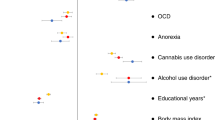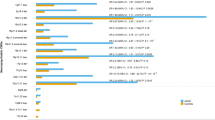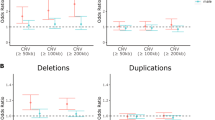Abstract
Attention deficit hyperactivity disorder (ADHD) is a highly heritable psychiatric condition of early childhood onset characterised by marked inattention, hyperactivity and impulsiveness. Molecular genetic investigations of ADHD have found positive associations with the 480-bp allele of a VNTR situated in the 3′ untranslated region of DAT1 and allele 7 of a VNTR in exon 3 of DRD4. A number of independent studies have attempted to replicate these findings but the results have been inconsistent. We used both family-based and case control approaches to examine these polymorphisms in a sample of 137 children diagnosed with ICD-10, DSM-IV or DSM-III-R ADHD. We found no evidence of association with the DAT1 polymorphism, despite a sample size that has up to 80% power to detect a previously reported effect size. We observed a significant increase in the DRD4 7 repeat allele amongst ADHD probands (21.7%) and their parents (18.9% in mothers, 22.3% in fathers), compared to ethnically matched controls (12.8%). However TDT analysis showed no preferential transmission of allele 7 to ADHD probands.
This is a preview of subscription content, access via your institution
Access options
Subscribe to this journal
Receive 12 print issues and online access
$259.00 per year
only $21.58 per issue
Buy this article
- Purchase on Springer Link
- Instant access to full article PDF
Prices may be subject to local taxes which are calculated during checkout
Similar content being viewed by others
References
Thapar A, Holmes J, Poulton K, Harrington R . Genetic basis of attention deficit and hyperactivity Br J Psychiatry 1999; 174: 105–111
Volkow ND, Wang GJ, Fowler JS, Gatley SJ, Logan J, Ding YS et al. Dopamine transporter occupancies in the human brain induced by therapeutic doses of oral methylphenidate Am J Psychiatry 1998; 155: 1325–1331
Cook EH, Stein MA, Krasowski MD, Cox NJ, Olkon DM, Keiffer JE et al. Association of attention def cit disorder and the dopamine transporter gene Am J Hum Genet 1995; 56: 993–998
Gill M, Daly G, Heron S, Hawi Z, Fitzgerald M . Confirmation of association between attention deficit hyperactivity disorder and a dopamine transporter polymorphism Mol Psychiatry 1997; 2: 311–313
Waldman ID, Rowe DC, Abramowitz A, Kozel ST, Mohr JH, Sherman SL et al. Association and linkage of the dopamine transporter gene and attention-deficit hyperactivity disorder in children: heterogeneity owing to diagnostic subtype and severity Am J Hum Genet 1998; 63: 1767–1776
Daly G, Hawi Z, Fitzgerald M, Gill M . Mapping susceptibility loci in attention deficit hyperactivity disorder: preferential transmission of parental alleles at DAT1, DBH and DRD5 to affected children Mol Psychiatry 1999; 4: 192–196
Lahoste GJ, Swanson JM, Wigal SB, Glabe C, Wigal T, King N et al. Dopamine D4 receptor gene polymorphism is associated with attention deficit hyperactivity disorder Mol Psychiatry 1996; 1: 121–124
Rowe DC, Stever C, Giedinghagen LN, Gard JMC, Cleveland HH, Terris ST et al. Dopamine DRD-4 receptor polymorphism and attention deficit hyperactivity disorder Mol Psychiatry 1998; 3: 419–426
Smalley SL, Bailey JN, Palmer CG, Cantwell DP, McGough JJ, Del'Homme MA et al. Evidence that the dopamine D4 receptor is a susceptibility gene in attention deficit hyperactivity disorder Mol Psychiatry 1998; 3: 427–430
Swanson JM, Sunohara GA, Kennedy JL, Regino R, Fineberg E, Wigal T et al. Association of the dopamine receptor D4 (DRD4) gene with a refined phenotype of attention deficit hyperactivity disorder (ADHD): a family-based approach Mol Psychiatry 1998; 3: 38–41
Palmer CGS, Bailey JN, Ramsey C, Cantwell D, Sinsheimer JS, Del'Homme M et al. No evidence of linkage or linkage disequilibrium between DAT1 and attention deficit hyperactivity disorder in a large sample Psychiatric Genet 1999; 9: 157–160
Castellanos FX, Lau E, Tayebi N, Lee P, Long RE, Gledd JN et al. Lack of an association between a dopamine-4 receptor polymorphism and attention deficit hyperactivity disorder: genetic and brain morphometric analyses Mol Psychiatry 1998; 3: 431–434
Thapar A . Attention deficit hyperactivity disorder: unravelling the molecular genetics Mol Psychiatry 1998; 3: 370–372
Angold A, Prendergast M, Cox A, Harrington R, Simonoff E, Rutter M . The Child and Adolescent Psychiatric Assessment Psychol Med 1995; 25: 739–753
Guy W . ECDELL Assessment Manual for Psychopharmacology Department of Health, Education and Welfare: Washington, DC 1976; pp 217–222
Telenius H, Carter P, Bebb C, Nordenskjold M, Ponder B, Tunnacliffe A . Degenerate oligonucleotide-primed PCR: general amplification of target Genomics 1992; 13: 718–725
Spielman RS, McGinnis RE, Ewens WJ . Transmission test for linkage disequilibrium: the insulin gene region and insulin-dependent diabetes mellitus (IDDM) Am J Hum Genet 1993; 52: 506–516
Schaid D, Rowland C . Use of parents, sibs, and unrelated controls for detection of associations between genetic markers and disease Am J Hum Genet 1998; 63: 1492–1506
Curtis D, Sham PC . A note on the application of the Transmission Disequilibrium Test when a parent is missing Am J Hum Genet 1995; 56: 811
Sham PC, Curtis D . An extended transmission/disequilibrium test (TDT) for multiallele marker loci Ann Hum Genet 1995; 59: 323–336
Stata Corp . Stata Statistical Software: Release 6.0 Stata Corporation: College Station, TX 1999
Raymond M, Rousset F . GENEPOP (version 1.2): population genetics software for exact tests and ecumenicism J Hered 1995; 86: 248–249
Guo SW, Thompson EA . Performing the exact test of Hardy–Weinberg proportions for multiple alleles Biometrics 1992; 48: 361–372
Schaid DJ, Sommer SS . Comparison of statistics for candidate-gene association studies using cases and parents Am J Hum Genet 1994; 55: 402–409
Camp NJ . Genomewide transmission/disequilibrium testing: a correction Am J Hum Genet 1999; 64: 1485–1487
Faraone SV, Lunetta K, Biederman J, Laid N . A family based association study of the dopamine D4 and the dopamine transporter gene in attention deficit hyperactivity disorder families Mol Psychiatry 1999; 4: S81
Asherson P, Virdee V, Curran S, Ebersole L, Freeman B, Craig I et al. Association study of DSM-IV attention deficit hyperactivity disorder (ADHD) and monamine pathway genes Am J Med Genet 1998; 81: 549
Bruun TG, Ewald H . Selection bias of susceptibility genes possible when using parent-offspring trios in genetic association studies Mol Psychiatry 1999; 4: 414–416
Page GP, Amos CI . Comparison of linkage-disequilibrium methods for localisation of genes influencing quantitative traits in humans Am J Hum Genet 1999; 64: 1194–1205
Strobel A, Wehr A, Michel A, Brocke B . Association between the dopamine D4 receptor (DRD4) exon III polymorphism and measures of novelty seeking in a German population Mol Psychiatry 1999; 4: 378–384
Acknowledgements
This study was funded by Action Research and SPARKS. We thank Kay Poulton for initial assistance with laboratory work; Nicole Perrin Trent for administrative support and all our colleagues from Child and Adolescent Psychiatry services in Greater Manchester and Cheshire, UK for referring families to the study. Finally, we are extremely grateful to all the families who participated in this study.
Author information
Authors and Affiliations
Corresponding author
Rights and permissions
About this article
Cite this article
Holmes, J., Payton, A., Barrett, J. et al. A family-based and case-control association study of the dopamine D4 receptor gene and dopamine transporter gene in attention deficit hyperactivity disorder. Mol Psychiatry 5, 523–530 (2000). https://doi.org/10.1038/sj.mp.4000751
Received:
Revised:
Accepted:
Published:
Issue Date:
DOI: https://doi.org/10.1038/sj.mp.4000751
Keywords
This article is cited by
-
Dopamine Receptor Expression and the Pathogenesis of Attention-Deficit Hyperactivity Disorder: a Scoping Review of the Literature
Current Developmental Disorders Reports (2022)
-
Genetic associations between ADHD and dopaminergic genes (DAT1 and DRD4) VNTRs in Korean children
Genes & Genomics (2018)
-
Is there a role for rare variants in DRD4 gene in the susceptibility for ADHD? Searching for an effect of allelic heterogeneity
Molecular Psychiatry (2012)
-
Role of Dopamine Receptors in ADHD: A Systematic Meta-analysis
Molecular Neurobiology (2012)
-
Candidate gene studies of ADHD: a meta-analytic review
Human Genetics (2009)



